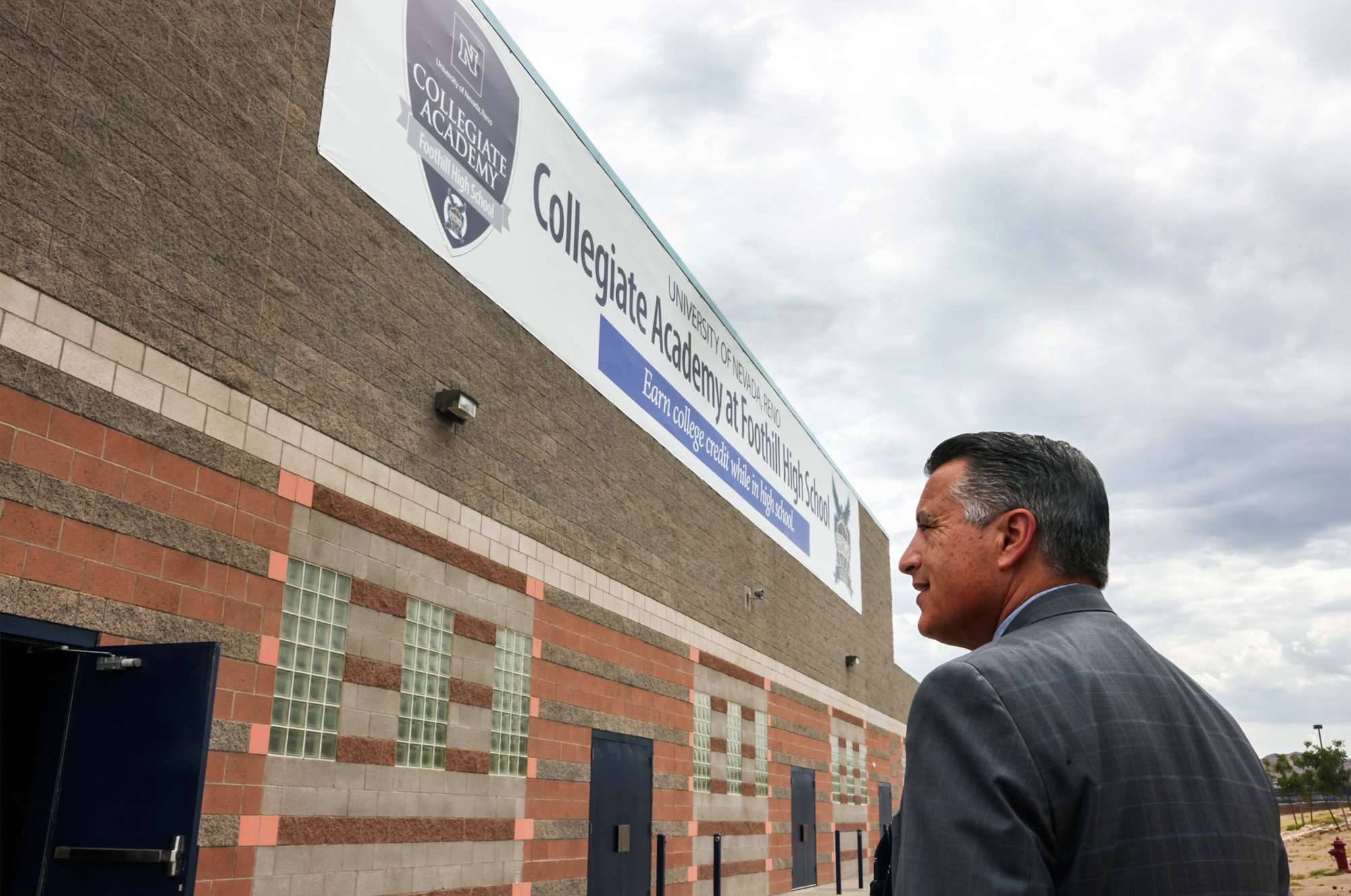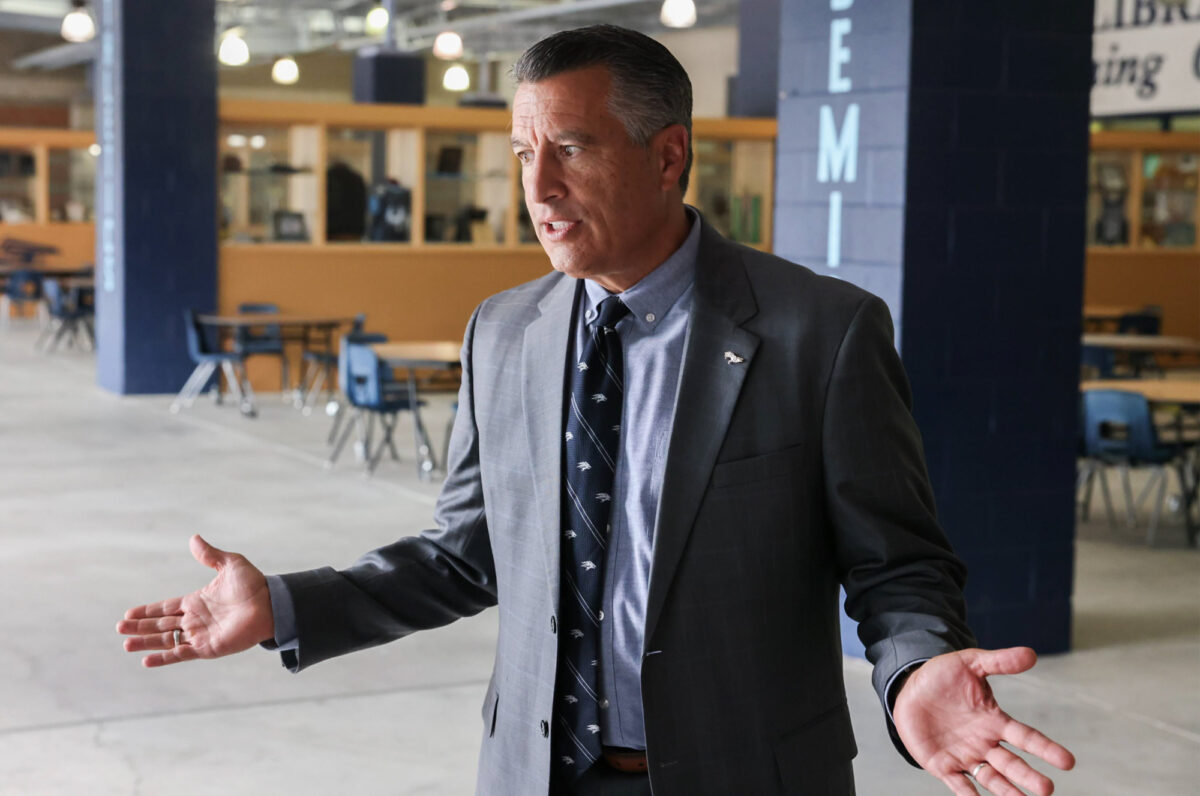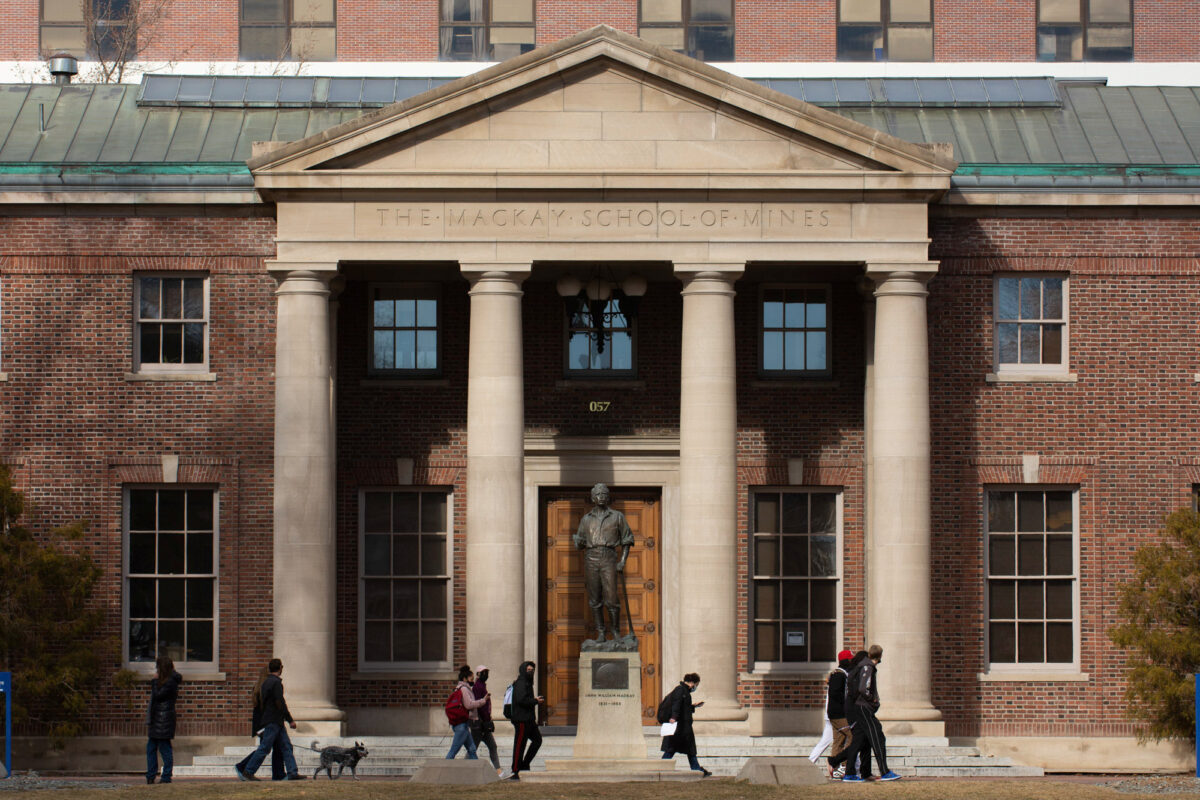Challenges emerge as UNR continues expansion of dual credit program into Southern Nevada

In a muggy, storm-drenched Las Vegas Valley, UNR President Brian Sandoval was on a mission.
Last week, he came to Foothill High School, a Henderson school just 3 miles from Nevada State University (NSU) and across the street from the College of Southern Nevada’s (CSN) Henderson Campus — a building so physically close that a skylight window in the shape of CSN’s seven-pointed logo peeks over the parking lot.
Sandoval had come to wrangle newfound goodwill for a program that has, for two years, been the axis on which the state’s north-south tensions spin: dual credit programs, classes taught by high school teachers aimed at getting high school students college credits.
He had also come just weeks after a little-publicized internal change within the Nevada System of Higher Education would cap stipends for teachers in the program starting next year, dropping UNR’s payments to teachers from $2,000 (significantly more than other Southern Nevada institutions paid for similar programs) to no more than $1,500.
The change comes both as the system has only recently begun to formalize aspects of dual enrollment programs — and as UNR’s sudden and rapid entrance into that ecosystem two years ago has reignited longstanding debates over the power of the state’s oldest university in Southern Nevada.
Inside a pair of Foothill classrooms, Sandoval absorbed the college-level teaching at work, only briefly interrupting lectures on the history of psychology and student-led presentations on early U.S. history. As he pulled his entourage along — including a regent, two Clark County School District (CCSD) officials, a UNR lobbyist and a reporter — his reputation only occasionally preceded him.
“Does anybody know what Mr. Sandoval has done previously?” Matt Iglitz, a social studies teacher, asked his class.
No student jumped to raise their hand, though not for lack of knowledge.
“Say it, I just saw you mouth it,” Iglitz said, pointing to the middle of the class.
“Governor of the State of Nevada.”
Still, much of Sandoval’s visit came not in the classroom, but in a closed-door roundtable with the regent, Amy Carvalho, and the CCSD contingent, namely College and Career Readiness and School Choice Unit head Gia Moore, alongside Foothill Principal Jonathan Synold.
There, Sandoval took on the role of interviewer. He asked Synold about the success of the dual credit program and sought to debunk what he described as “whispers” from other institutions in Southern Nevada engaged in similar dual credit work.
He addressed implications from “other institutions” that UNR’s dual credit high school teachers “are not qualified to teach our courses,” that UNR was flexing financial muscle with large teaching stipends, that “we were out trying to outbid everyone.”
Sandoval denied such “whispers,” defending the rigor of instruction and the scale of the university’s compensation plans. Synold, too, argued that his teachers were qualified. “A lot of them have experience teaching [Advanced Placement], those are much harder than a lot of entry level classes,” he said.
Still, Sandoval continually raised the specter of behind-the-scenes friction, one that had now started to roll back elements of UNR’s program.
“It's created this perception that we're predatory,” Sandoval told the group. “When it’s purely — we’re serving students.”

The road to dual credit
For two years, UNR has worked to expand a pilot program for dual credit coursework in Las Vegas high schools.
It came at the behest of Clark County School District Superintendent Jesus Jara, who met with Sandoval in 2021 in a bid to bring UNR coursework into two urban Las Vegas high schools: Cheyenne and Centennial. Since then, UNR has opened dual enrollment programs at 17 Las Vegas high schools, as well as six Washoe County schools, two charter schools and agricultural programs in Elko and Churchill counties.
Dual credit programs — also frequently called dual enrollment or concurrent enrollment, depending on the type of program — generally allow high schoolers to earn college credits for core undergraduate courses while still in high school, learning from high school teachers at a sharply reduced per-credit fee (just $75 compared to nearly $275 at UNR and UNLV).
Those fees can be further reduced through scholarships, with funding sources ranging from federal grants funneled through CCSD to philanthropic partnerships.
Dual credit pathways have existed for years in Nevada, largely under the purview of the College of Southern Nevada and, more recently, Nevada State University. Even after the expansion of UNR’s program, that remains true.
Nevada System of Higher Education (NSHE) data from last year shows that of the roughly 15,500 high school students in dual enrollment coursework, 33.7 percent enrolled in CSN-offered programs and 19.7 percent went through Nevada State (though the numbers also include other college-offered efforts such as career and technical certificate programs).
Put another way: Of those 15,500, nearly more than 5,200 were enrolled through CSN and more than 3,000 through Nevada State as of last school year, compared to about 650 students at UNR (a number expected to increase substantially this year).
Those programs are different from similar Advanced Placement (AP) programs, in that they do not require students to pass an additional paid standardized test in order to earn the credit, only requiring them to pass the class.
Synold, the Foothill principal, said that difference has created an explosion of interest in college-level coursework among students who otherwise never would have taken the risk on an AP-level course.
“I said ‘Sign us up, let's do it, we need that here,’” he said. “Because we need to have a hook to keep kids interested, coming to school, engaged and seen as a pathway to college.”
What followed “all happened really fast,” he said. Between 2022 and 2023, the number of dual enrolled Foothill students in UNR classes jumped from 104 to 542, with the number of individual courses taken jumping from 229 to 1,080.
Administrators at CCSD and UNR have also credited dual credit programs for providing a welcome alternative to AP classes, given many students either didn’t have access to those classes or didn’t want to risk the money on a college credit depending on the outcome of a single test.
A CCSD equity study from 2020 tagged AP availability as one of a handful of key “failure points” for equity, with 14 high schools offering less than the minimum 16 AP courses required by the district.
With AP, Synold said, “inequities are all over the place.”
“At Coronado [a Henderson high school located in a relatively wealthy suburban enclave], you probably did test sessions, probably had an AP teacher who's been doing it for 20 years, knows that test inside-out,” he said. “You think of Cheyenne, that they have a teacher like that? No, they probably have a second-year person, new at it. Whereas dual credit — at least it's fair.”
More than that, Synold said simply having the university brand attached to the dual credit pathway helped seal the deal on such classes among a key constituency: parents.
“We always told them, your transcripts with CSN and Nevada State, you can use that anywhere across the country,” Synold said. “And that's pretty true. The reality was the parents didn't believe it. With UNR, they believe it.”
Synold said the UNR dual credit program has an added benefit — creating an environment in which teachers, communicating broadly across different schools across the valley, have begun to homogenize grading, and adding a more consistent application of academic rigor.
“That's why students, when they get to college, they think ‘I'm a straight A kid, I'll nail it,’” Synold said. “And they get there and they struggle. Because it wasn't the same rigor.”

The funding question
Sandoval’s visit came in the wake of an administrative move to impose new caps on the stipends UNR — or, theoretically any institution engaged in dual credit — is allowed to give high school teachers for their work outside the classroom.
Since founding the pilot program, UNR has offered $2,000 to participating high school teachers, with half — $1,000 — dedicated toward a stipend for that outside work, which includes weekly check-ins with UNR faculty and additional time spent on grading.
It was a substantial increase from the $250 stipend provided by CSN, still the largest dual credit program in Nevada. But that half of the stipend — dedicated to the work teachers devote to the program outside the classroom — may drop from $1,000 to $500 as soon as next year, under internal guidelines adopted by NSHE academic officers and the chancellor’s office earlier this month.
After weeks of internal debate, top academic officers at six Nevada System of Higher Education Institutions voted — with only UNR in opposition — to cap such outside work stipends at $500, with an additional cap of $1,000 for instruction.
That vote was formalized through the chancellor’s office early this month, as part of the system’s Procedures and Guidelines Manual — a document that does not require approval from the elected Board of Regents, such as NSHE’s internal code.
Describing internal debates that have been running since at least last September, CSN Vice President for Academic Affairs James McCoy told The Nevada Independent that “we were all over the place across the state,” and that academic officers more broadly “did not reach agreement, as a body, to what that dollar amount ought to be.”
“It was important for us to at least as a system provide some equity, balance and consistency within that figure,” McCoy said.
To that end, McCoy pointed to the procedural changes and recent informational presentations to regents as key evidence that the system was “seeing the light, that this is coming to a head.”
UNR Provost Jeff Thompson said UNR’s high stipend was intended to be “respectful of their [teachers’] time.”
“We require quite a bit of engagement and, so for me, over a semester, the hourly rate to get to $1,000 is pretty low for a teacher to be engaged,” Thompson said. “And it's not, ‘We want them to do it,’ it's a requirement. In order to teach the class, they have to participate in this support system that is outside of the classroom.”
The new cap on stipends remains relatively unknown, with teachers and administrators not fully informed of the administrative change. Synold — the Foothill principal — said he did not know it had happened until Sandoval told him during the roundtable last Friday.
But CCSD's Moore, responding to the stipend issue, told Sandoval on Friday that she “took offense” to the implication that teachers only signed up for UNR’s program because of the chance for increased pay.
“That wasn’t even part of the equation to begin with; they [teachers] don’t even have an understanding of that until well after,” Moore said. “It’s just a nice bonus.”
A matter of qualification
Adding fuel to the debate are renewed questions over just what kind of high school teacher should be allowed to teach a college level course.
Notably, CSN has used a model that requires at least a master’s degree for such teachers. But that model has been eschewed by UNR, which instead uses more frequent contact between college professors and high school teachers picked by the respective schools.
McCoy, CSN’s top academic officer, said their requirements had little to do with preference, and more to do with guidelines from regional and national accrediting bodies.
That includes the regional accreditor — the Northwest Commission on Colleges and Universities (NWCCU) and the National Alliance of Concurrent Enrollment Partnerships (NACEP). Key to the debate now, McCoy said, is a nuance between what NWCCU has — and has not — mandated, and whether or not schools are bound to NACEP guidelines as a result.
Among those NACEP requirements: That high school-level instructors meet the same academic requirements for faculty and instructors teaching at post-secondary institutions.
“[NWCCU] said ‘Northwest institutions, we believe you ought to follow the NACEP standards,” McCoy said. “They didn't dictate it, they said you ought to follow it.”
He added, however, that the NWCCU also required institutions to maintain consistent policies governing requirements for what degrees instructors need in order to teach coursework on the main campus.
“The [NWCCU] has made it clear: Have a policy and follow it,” McCoy said.
Thus, McCoy said, teaching an entry-level biology course at either CSN or a high school should require the same credentials.
“The challenge comes in where you have a requirement for a graduate-level of degree to deliver college-level courses on your home campus, but you're turning a blind eye to that same qualification requirement for high school teachers,” McCoy said.
In interviews, UNR administrators have repeatedly defended the rigor of their approach.
Thompson, the UNR provost, argued that UNR professors first had to approve teachers already selected by participating high schools — often teachers with experience teaching honors, AP or other advanced courses — after which teachers would have to continue performing at a specified level to remain in the program.
“If teachers are not able to do that or not willing to do that, we engage principals,” Thompson said. “We have only done this once; we have removed a teacher from teaching our courses. And I want to make it very clear, they’re teaching university courses, a UNR course. This is not a high school course.”
Still, Thompson described UNR’s conversations with the NWCCU as a “dialogue,” and signaled that though UNR would seek formal accreditation from NACEP sometime soon, the process still remained in an early phase.
“I mean, it's a long academic process to secure accreditation,” Thompson said. “We'll submit a proposal and, at that point, they will come out and visit and have us demonstrate that we meet their standard. And we're confident we'll be able to do it.”
